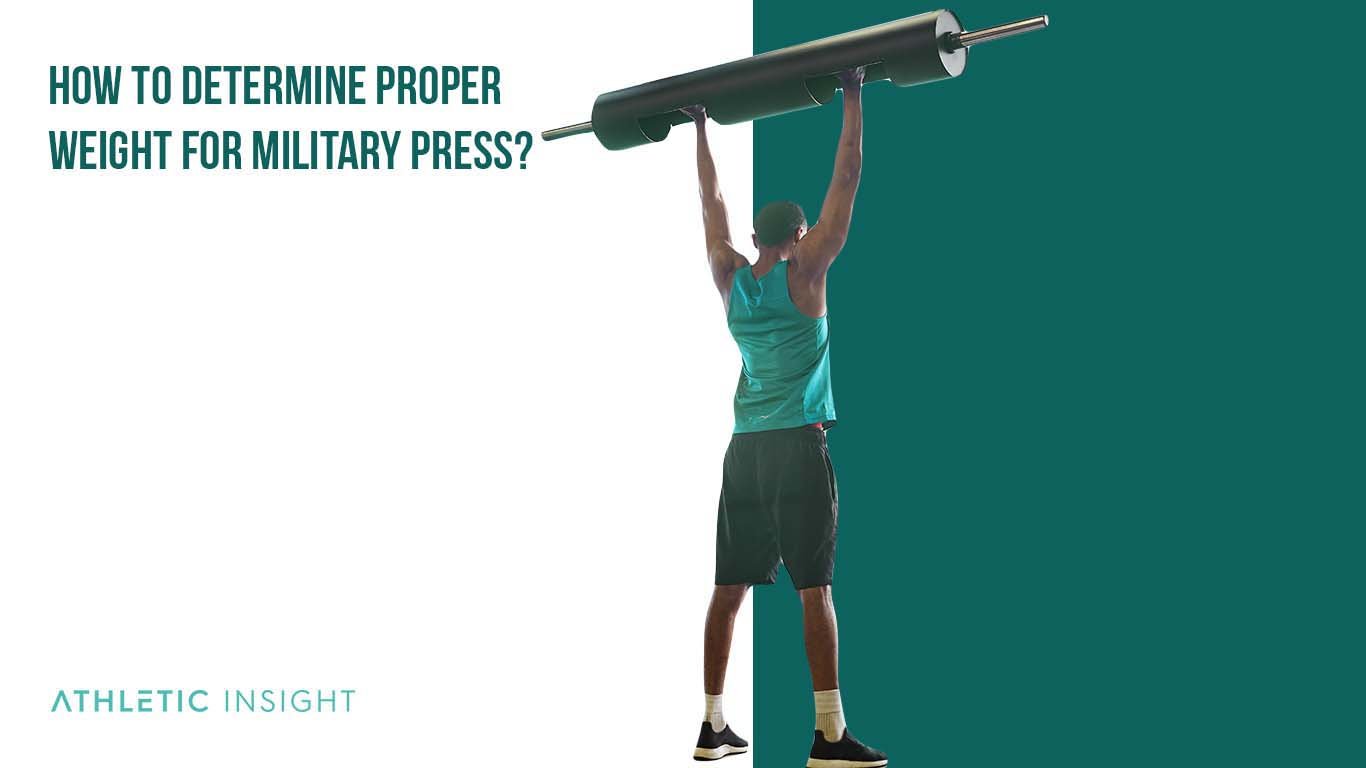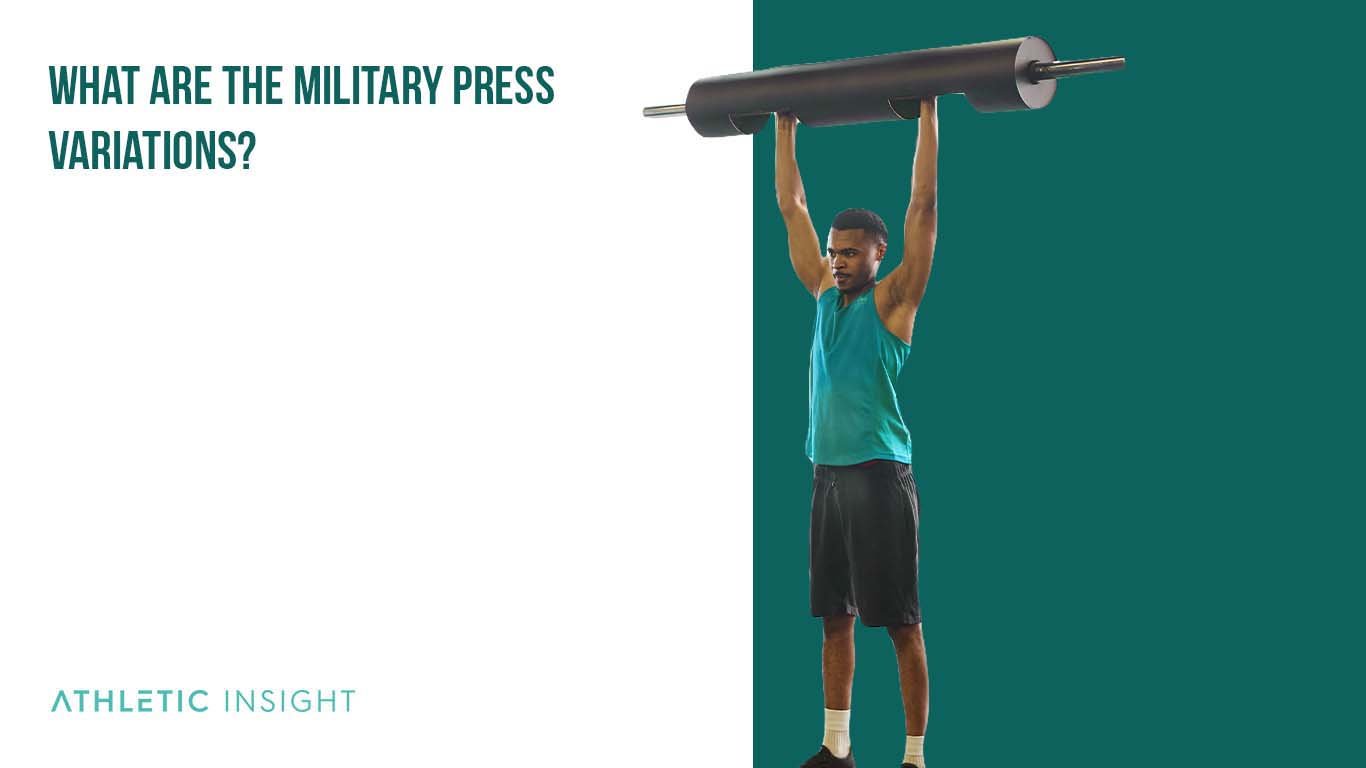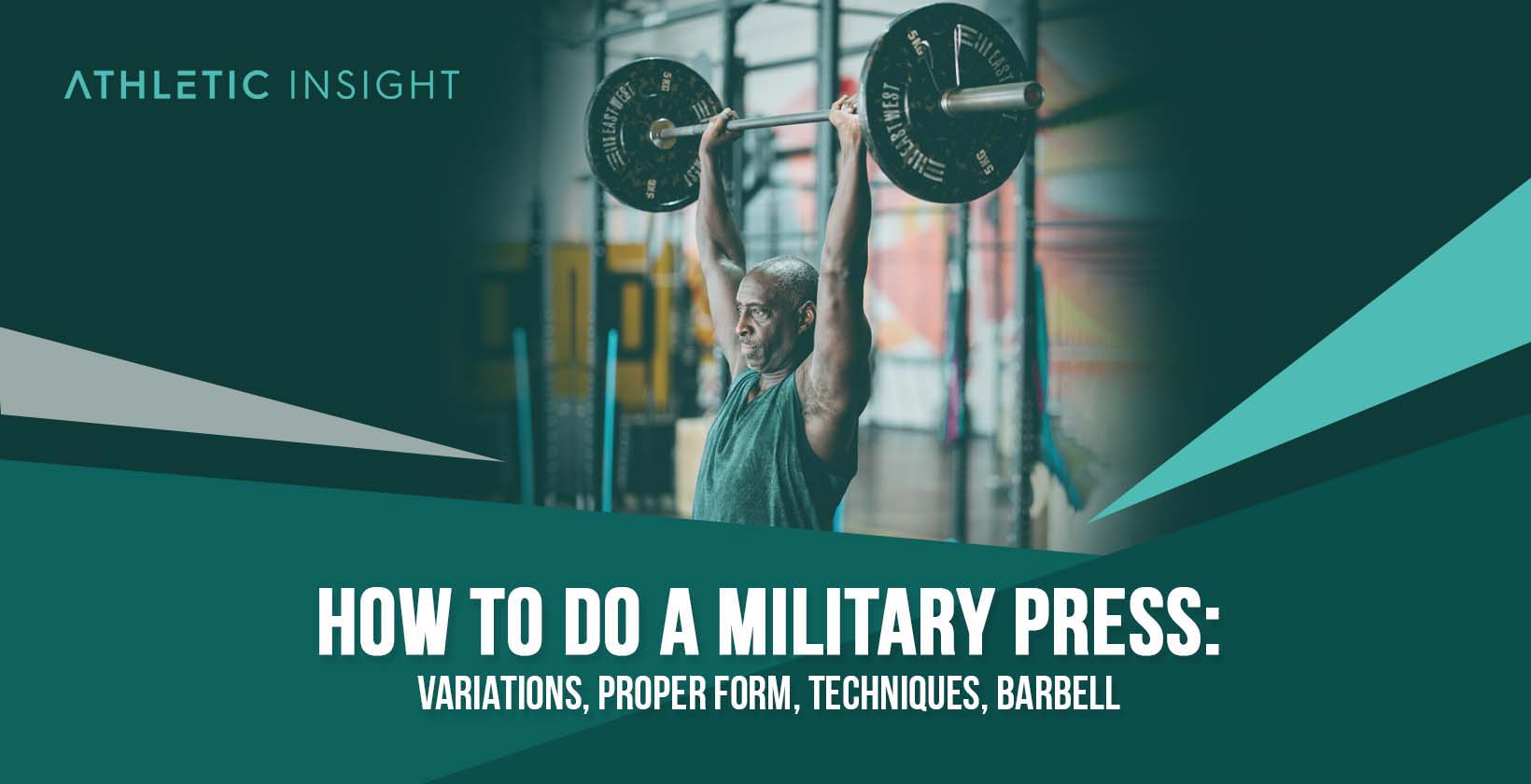The military press, also known as an overhead press, is a compound weight training exercise that targets the deltoids, triceps brachii, and trapezius muscles. The military press is used to strengthen the muscles and improve definition and size.
The military press is performed by pressing a barbell over your head at a 90-degree angle from the ground. If you have a barbell and weighted plates, you can easily perform this movement in the comfort of your own home.
While the military press is simple to perform, it is recommended to focus on form with just the bar before adding weight. If too much weight is added, or the form is improper, this may lead to joint pain, muscle tears, or spinal injuries. Athletes performing a military press can also use bands if weight is not available or if the athlete does not feel comfortable adding more weight.
The military press is an effective weight training exercise for athletes of all sports. Whether you are an Olympic weightlifter, a Strongman competitor, CrossFit performer, or just a bodybuilder, the military press is highly recommended.
How to Perform Military Press with Proper Form?
One of the most important aspects of performing the military press is utilizing correct form and safety techniques. Incorrectly performing the military press can result in muscular imbalances, structural deformities, and impedance of range of motion in the shoulder.
Athletes performing the military press must keep in mind certain aspects of ‘proper form’ before beginning this shoulder exercise.
- ‘Form’ is the methodology in which an individual is supposed to do a specific exercise.
- Looking up instructional videos and articles before performing an exercise is an efficient way to visualize proper form and avoid risky mistakes.
- Keep in mind that the dumbbell military press form will differ from the barbell military press form.
- Proper form – Although these two terms get confused, ‘form’ and ‘technique’ are two different things. The technique is the specific way someone does an exercise to hit a muscle group (e.g. bicep curl to target their biceps). The form is ensuring the exercise is done safely to avoid injury (e.g. not bending backward while doing the ascent portion of the military barbell press).
Proper form is necessary to safely perform the military press exercise. Let’s check out the must-do steps to dominate the military press and reap the benefits of this shoulder-specific exercise.
- Place the bar at around shoulder height in a squat rack.
- Take hold of the bar with both hands.
- Place the palms down and shoulder-width apart.
- Assume a straight line from the bar passes through the middle of your foot.
- Bring your upper chest to the bar so that it sits above your shoulders.
- Touch the base of your throat.
- Bring your shoulders beneath the bar.
- Rest the bar on your deltoids and upper chest.
- Lift the bar off the rack.
- Step back with each foot.
- Place them shoulder-width apart.
- Reach the bar to your forehead.
- Put your chest beneath it and push it up until your arms are locked out.
- Reverse the motion to return the bar to your chest to get ready for the next rep.
Safety tip:
Weightlifters should also keep in mind the differences between a barbell and a dumbbell military press before beginning with the how-to steps. Dumbbells are separate weights, whereas a barbell is a conjoined weight. The performer will need two dumbbells to perform the military press, whereas only one barbell is required to do the military barbell press.
If you are still not sure if the military press is for you, there are countless shoulder exercises that will give you the same shoulder muscle development as the military press.
What are the Phases of Military Press?
Understanding the phases of the military press is essential to keeping proper form and safety throughout each step. If you only focus on phase one of the exercise, you may adopt unsafe techniques during the later steps. Unsafe techniques can lead to injury. Remembering specific cues and tips during all three phases of the military press helps keep users aware of what they are doing and avoid any potential mistakes.
Let’s evaluate the three must-include phases of the standing and seated military press to do this exercise safely and effectively.
- The Setup – The setup is the first portion of the military press exercise. Athletes must properly rack the barbell on a squat rack at shoulder height to safely start with the weight at their shoulders. They must ensure an imaginary straight line can pass from the bar down to the middle of the foot to ensure lifting stability. If the person is using dumbbells, choosing dumbbells that are light enough to safely lift to shoulder height is essential to overall safety.
- The Ascent – The ascent is the first moving phase of the military press. During the ascent, the person will start with their shoulders beneath the bar and rest the bar on their deltoids and upper chest. The next portion involves lifting the bar off the rack, stepping back with each foot to a position shoulder-width apart, and pushing the bar until your arms are locked out.
- The Descent – The descent involves a reversed repetition of the same motions in the ascent phase to safely lower the bar back down to the chest.
What are the Benefits of Overhead Press?
There are numerous benefits of the military press/overhead press for athletes and regular gym-goers alike.

- Increases the Size for Shoulder Muscle Mass – For bodybuilders, individuals who need to put on weight, and specific athletes, increasing the size and mass of shoulder muscles can be essential. Performing the overhead press is one of the best ways to specifically target the shoulder muscles safely and effectively. Individuals who are looking to increase the mass of their shoulders should take into account proper programming and weight selection.
- Increases the Strength of the Back Muscles – Pressing heavyweight overhead requires stability from your shoulder and back muscles. Without back strength, the individual will not be able to stabilize the weight over their head and safely lower the dumbbells or barbell back to the rack position. Safely performing an overhead press is one of the most effective ways to increase the strength of your upper rhomboids and trapezius muscles without directly targeting them via cable rows, bent-over rows, or lat pulldowns.
- Improves the Triceps – The third benefit of the overhead press is improving the functionality of the triceps. This muscle on the posterior of your arm is the direct agonist of the biceps and helps balance your arm muscles and aid in pushing motions. Triceps are directly involved in numerous exercises that can increase a person’s functionality, such as push-ups, dips, overhead presses, and tricep extensions.
- Improves Core Muscles – The last benefit of the overhead press is building the athlete’s core muscles. Core strength and stability are required to press an unsteady object overhead, as you do with a dumbbell overhead press or barbell overhead press. The person must engage their core at almost all points throughout their range of motion, especially during the lock-out phase of the exercise and the descent phase.
What are the mistakes in Military Press form?
The importance of good military press form cannot be overstated when it comes to correct military press techniques. Performers must focus on the form and safety tips to ensure they safely build muscle, improve range of motion, and avoid any long-lasting injuries.
The most common barbell military press mistakes, made by both beginner gym rats and advanced users, are the following:
- Putting too much weight on the bar to keep proper form
- Not locking out your elbows at the top of the press
- Pressing the barbell outwards instead of directly up and in line with your body
- Not controlling dumbbells during the military press
- Rotator or cartilage tear due to improper form
Poor military press form and excess weight lead to overuse injuries and repetitive-motion injuries. The most common military press injuries include shoulder strains, muscle tears, and rotator cuff injury/dislocation.
How to Determine Proper Weight for Military Press?
Choosing the wrong weight for the military press can be detrimental to muscle growth and increase the risk of injury. Athletes should select their weight level for the military press by seeing when they can perform more reps and sets than previously programmed – once this happens, the person can increase the weight used by around 5% and alter the reps/sets based on specific weightlifting goals. Furthermore, the military press dumbbell exercise model uses the same technique to select safe weights for the overhead exercise.

Which muscles are involved while performing Military Press?
The muscles used in the military shoulder press focus on the shoulders specifically, with a secondary focus on the core, back, and chest. There are a few main muscles taxed during the military press which create a balanced synergy of effort.
- Deltoid – The deltoids are your shoulder muscles
- Pectorals – Your chest muscles help during the ascent motion and stability at the top of the lift
- Triceps – Triceps directly engage during the push/ascent phase of the military press
- Trapezius – The trapezius, or upper back, are stabilizers that keep the weight firmly overhead before starting the descent phase
The military press benefits these muscles by putting strain on the user’s back, core, shoulders, chest, and triceps. While the weight is overhead, the individual will have to adapt to the ever-changing balance by ensuring proper stability and strength to keep the weight in one location.
What are the Military Press Variations?
A military press variation is another method of doing the military press exercise using different equipment to alter the function of the exercise or the muscular focus.

- Seated Military Press – The seated military press involves using a barbell while in a seated position. The performer can rack the barbell on the squat rack or other racking apparatus and place a movable bench (with a seat back) directly under the bar. The user will unrack the bar and perform the same phases as the standing overhead press while sitting on the seat/bench.
- Push Press – The push press is a useful exercise for athletes who are looking to develop more power. Instead of using solely shoulder and back muscles to lift the bar overhead, the individual can gain power from their legs to ‘dip’ down and drive up with their leg muscles to power the weight overhead.
- Seated Dumbbell Military Press – This is the same setup as the seated military press, except the performer, will have two dumbbells instead of one barbell. The weightlifter must be able to safely lift the dumbbells from the floor/knees to their shoulders to begin the exercise.
- Dumbbell Arnold Press – The Arnold Press is a famous variation that includes the anterior deltoids (front shoulder muscles) due to internally rotating the weights during the descent phase and externally rotating the weights during the ascent.
- Smith Machine Military Press – The Smith machine is a useful apparatus for novice exercisers and athletes who may need a little extra stability during the overhead lifting portion of the exercise. The Smith machine uses a barbell on a track, meaning the athlete does not need to use their core strength or back stabilizer muscles to keep the bar in an overhead path.
What is the necessary equipment for the Military Press?
Curious how to do military press? The first thing you need is proper equipment. The military press has multiple variations that require different pieces of equipment to safely perform. The most common pieces of equipment needed for a best military press include a barbell, dumbbells, bench, or Smith machine.
What are the back muscle exercises with Military Press?
What muscles does military press work? The press builds shoulder muscles, but also improves back muscle strength! Using the military press for back muscles is a successful way to target the trapezius muscles.
Performers can incorporate the military press for back stability and strength by super setting the military press with a chest-focused exercise to successfully balance muscle groups.
- Military Press for Back – Complete 3-4 sets of 5-8 reps for muscle growth or 3-4 sets of 12-15 reps for muscular endurance.
What are the Military Press-related facts?
The military press is a beneficial exercise that leads to multiple changes within the body. Both the barbell military press and the dumbbell military press can increase hormone production, alter a person’s mood, and increase strength and stability in other surrounding muscle groups.
Does the Military Press affect hormones?
Doing the barbell military press, dumbbell military press, or Smith machine military press all affect hormones production in the body. The amount of serum and testosterone increases in the body after consistent strength training. The serum basal testosterone concentration is increased by consistent strength training, structured load, and programmed workout plans.
Does Military Press Increase Testosterone?
Performing the standing or sitting military press increases testosterone in the user’s body. Testosterone is a hormone that aids in cardiovascular health, muscle growth, strength, and cognitive function. This compound exercise taxes multiple muscles in the body, increasing testosterone production due to the effort on the user’s shoulders, back, chest, core, and lower back.
Does the Military Press affect the mood?
Yes, the seated military barbell military press affects a person’s mood by altering hormone production and estrogen production. The military press can reduce stress hormones and release endorphins, which can lead to a boost in mood and elevated spirits.
Is Military Press practiced within CrossFit?
Yes, the front military press is practiced within Crossfit to improve shoulder strength, boost shoulder range of motion, and increase stability. Although the military press is not used during competitions or considered one of the major lifts, this exercise can help performance with overhead squats and snatches.
Is the Military Press a military movement?
Yes, the military press is a compound military movement.
Is the Military Press push or pull?
The military press is a push exercise. Push refers to any exercise in which the (front) muscles are used, compared to the posterior muscles for pull exercises.
Is Military Press essential?
Yes, the military press is essential to building shoulder strength, increasing shoulder stability, and improving core/back stability. The military press with dumbbells increases the strain on the core and shoulder muscles, making this a successful exercise to boost upper body strength and range of motion.
Is the Military Press dangerous?
No, doing this exercise with proper military press form is not a dangerous exercise for most workout programs. The military press world record is currently 212.5kgs, held by Zydrunas Savickas.
Is Military Press a compound exercise?
Yes, the military press is a compound exercise. Compound movements are exercises that incorporate multiple muscle groups, such as squats, deadlifts, or pushups. A proper military press uses multiple muscle groups, including the shoulder muscles, back stabilizers, and core muscles. Another military press alternative that is also a compound exercise is the seated military press or dumbbell military press.
What is the difference between Military Press to Shoulder Press?
The difference between the military press and the shoulder press is that the military press targets the deltoids and triceps whereas the shoulder press mainly targets the deltoids.



